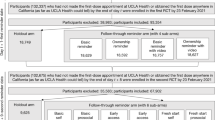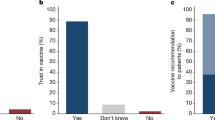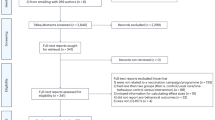Abstract
Here we report the results of two nationwide randomized controlled trials. By refining behavioural-science-informed text messages notifying patients of their vaccine eligibility, we observed improvements in vaccination rates. The randomized controlled trials involved adults aged 40–44 years (n = 1,825,937) and 24–29 years (n = 2,174,064) in England. Messages emphasizing ‘Top of queue’ status led to small, but policy-relevant, increases in vaccination rates in both the 40–44 age group (odds ratio 1.02, 95% confidence interval 1.01–1.03) and the 24–29 age group (odds ratio 1.02, 95% confidence interval 1.01–1.04). Consequently, the ‘Top of queue’ message was nationally rolled out to other age groups. These findings demonstrate the potential of ‘queue’ framing in relevant contexts and the value of rigorous testing of public health messaging.
This is a preview of subscription content, access via your institution
Access options
Access Nature and 54 other Nature Portfolio journals
Get Nature+, our best-value online-access subscription
$29.99 / 30 days
cancel any time
Subscribe to this journal
Receive 12 digital issues and online access to articles
$119.00 per year
only $9.92 per issue
Buy this article
- Purchase on SpringerLink
- Instant access to full article PDF
Prices may be subject to local taxes which are calculated during checkout




Similar content being viewed by others
Data availability
All data requests should be submitted to NHS England (the data controller) for consideration. Access to the raw anonymized data may be granted for non-commercial research at the discretion of NHS England. Further information can be obtained from the corresponding author.
Code availability
Custom code that supports the findings of this study is available via GitHub at https://github.com/BehaviouralInsights/Nature-Human-Behaviour-Beherendt-et-al-2005.
References
Jacobson Vann, J. et al. Patient reminder and recall interventions to improve immunization rates. Cochrane Database Syst. Rev. 1, CD003941 (2018).
Hallsworth, M. et al. Stating appointment costs in SMS reminders reduces missed hospital appointments: findings from two randomised controlled trials. PLoS ONE 10, e0137306 (2015).
Milkman, K. et al. A megastudy of text-based nudges encouraging patients to get vaccinated at an upcoming doctor’s appointment. Proc. Natl Acad. Sci. USA 118, e2101165118 (2021).
Dai, H. et al. Behavioral nudges increase COVID-19 vaccinations. Nature 597, 404–409 (2021).
Strategy to Achieve Global COVID-19 Vaccination by Mid-2022 (WHO, 2021); https://www.who.int/publications/m/item/strategy-to-achieve-global-covid-19-vaccination-by-mid-2022
Brewer, N. et al. Increasing vaccination: putting psychological science into action. Psychol. Sci. Public Interest 18, 149–207 (2017).
Sheeran, P. Intention–behavior relations: a conceptual and empirical review. Eur. Rev. Soc. Psychol. 12, 1–36 (2002).
Webb, T. & Sheeran, P. Does changing behavioral intentions engender behavior change? A meta-analysis of the experimental evidence. Psychol. Bull. 132, 249–268 (2006).
Smith, L. et al. Psychological factors associated with uptake of the childhood influenza vaccine and perception of post-vaccination side-effects: a cross-sectional survey in England. Vaccine 35, 1936–1945 (2017).
Campos-Mercade, P. et al. Monetary incentives increase COVID-19 vaccinations. Science 374, 879–882 (2021).
Schneider, F. et al. Financial incentives for vaccination do not have negative unintended consequences. Nature 613, 526–533 (2023).
Patel, M. et al. Effect of text message reminders and vaccine reservations on adherence to a health system COVID-19 vaccination policy: a randomized clinical trial. JAMA Netw. Open 5, e2222116 (2022).
Chapman, G. et al. Opting in vs opting out of influenza vaccination. JAMA 304, 43–44 (2010).
Milkman, K. et al. Using implementation intentions prompts to enhance influenza vaccination rates. Proc. Natl Acad. Sci. USA 108, 10415–10420 (2011).
Reminder Systems for Immunizations and Preventive Services (Agency for Healthcare Research and Quality, 2017); https://www.ahrq.gov/sites/default/files/wysiwyg/cahps/quality-improvement/improvement-guide/6-strategies-for-improving/health-promotion-education/cahps-strategy-6-r.pdf
Esposito, S. et al. Barriers to the vaccination of children and adolescents and possible solutions. Clin. Microbiol. Infect. 20, 25–31 (2014).
Pereira, J. et al. Barriers to the use of reminder/recall interventions for immunizations: a systematic review. BMC Med. Inform. Decis. Mak. 12, 145 (2012).
Rabb, N. et al. Evidence from a statewide vaccination RCT shows the limits of nudges. Nature 604, E1–E7 (2022).
Thomas, R. & Lorenzetti, D. Interventions to increase influenza vaccination rates of those 60 years and older in the community. Cochrane Database Syst. Rev. 5, 1465–1858 (2018).
Kempe, A. et al. Population-based versus practice-based recall for childhood immunizations: a randomized controlled comparative effectiveness trial. Am. J. Public Health 103, 1116–1123 (2013).
Hawe, P. et al. Randomised controlled trial of the use of a modified postal reminder card on the uptake of measles vaccination. Arch. Dis. Child. 79, 136–140 (1998).
Milkman, K. et al. A 680,000-person megastudy of nudges to encourage vaccination in pharmacies. Proc. Natl Acad. Sci. USA 119, e2115126119 (2022).
Buttenheim, A. et al. Effects of ownership text message wording and reminders on receipt of an influenza vaccination: a randomized clinical trial. JAMA Netw. Open 5, e2143388 (2022).
How you will be contacted for your coronavirus (COVID-19) vaccination. NHS England https://www.nhs.uk/conditions/coronavirus-covid-19/coronavirus-vaccination/how-you-will-be-contacted/ (2021).
Third Quarterly Report on Progress to Address COVID-19 Health Inequalities (Cabinet Office Race Disparity Unit, 2021); https://www.gov.uk/government/publications/third-quarterly-report-on-progress-to-address-covid-19-health-inequalities/third-quarterly-report-on-progress-to-address-covid-19-health-inequalities
Independent Report: JCVI Final Statement on Phase 2 of the COVID-19 Vaccination Programme (Department of Health and Social Care, 2021); https://www.gov.uk/government/publications/priority-groups-for-phase-2-of-the-coronavirus-covid-19-vaccination-programme-advice-from-the-jcvi/jcvi-final-statement-on-phase-2-of-the-covid-19-vaccination-programme-13-april-2021
Imas, A. & Madarász, K. Superiority-seeking and the preference for exclusion. Rev. Econ. Stud. 91, 2347–2386 (2024).
Statistical Bulletin Coronavirus and Vaccine Hesitancy, Great Britain: 28 April to 23 May 2021 (Office for National Statistics, 2021); https://www.ons.gov.uk/peoplepopulationandcommunity/healthandsocialcare/healthandwellbeing/bulletins/coronavirusandvaccinehesitancygreatbritain/28aprilto23may2021
Moehring, A. et al. Providing normative information increases intentions to accept a COVID-19 vaccine. Nat. Commun. 14, 126 (2023).
Freeman, D. et al. Effects of different types of written vaccination information on COVID-19 vaccine hesitancy in the UK (OCEANS-III): a single-blind, parallel-group, randomised controlled trial. Lancet Public Health 6, e416–e427 (2021).
Wise, J. Monkeypox: UK to run out of vaccine doses by next week. Br. Med. J. 378, o2053 (2022).
COVID autumn booster vaccine 2023: everything you need to know. Department of Health and Social Care https://healthmedia.blog.gov.uk/2023/08/08/covid-autumn-booster-vaccine-2023-everything-you-need-to-know/ (2023).
Lee, D. et al. Association of vaccine stockout with immunisation coverage in low-income and middle-income countries: a retrospective cohort study. BMJ Open 13, e072364 (2023).
Acknowledgements
The trials were funded by the UK Department of Health and Social Care and NHS England and NHS Improvement. We thank C. Bemand, M. Egan, H. Fowler, C. Gilbert, Z. Goozee, M. Hallsworth, I. Ifeacho, M. Kane, B. King, C. Kume-Holland, J. Lawrence, I. McAloon, T. McMaster, S. Merriam, R. Rackham, B. Reitsma, A. Sandrawich, P. Shrestha, V. Susanina, A. Sutherland, J. Tilbury, J. Whitwell-Mak, D. Wilson, A. Worsley and F. Young for their contributions.
Author information
Authors and Affiliations
Contributions
H.B., G.T., Y.X., H.H., N.G., D.W., R.R. and R.S. conceived the study and contributed to the study design. H.B., G.T. and Y.X. developed the trial protocol. H.B. and G.T. were responsible for the study implementation and project management for studies 1 and 2. G.T., L.T. and Y.X. conducted the statistical analysis for study 1. G.T. and Y.X. conducted the statistical analysis for study 1. H.B., G.T., L.T. and Y.X. contributed to the interpretation of the data and the writing of the paper. All authors were responsible for editing and approving the paper.
Corresponding author
Ethics declarations
Competing interests
The authors declare no competing interests.
Peer review
Peer review information
Nature Human Behaviour thanks Gretchen Chapman and the other, anonymous, reviewer(s) for their contribution to the peer review of this work.
Additional information
Publisher’s note Springer Nature remains neutral with regard to jurisdictional claims in published maps and institutional affiliations.
Supplementary information
Supplementary Information
Supplementary methods, results, Figs. 1 and 2 and Tables 1–16.
Supplementary Table 1
Supplementary tables—exploratory analysis of heterogeneous treatment effects.
Rights and permissions
Springer Nature or its licensor (e.g. a society or other partner) holds exclusive rights to this article under a publishing agreement with the author(s) or other rightsholder(s); author self-archiving of the accepted manuscript version of this article is solely governed by the terms of such publishing agreement and applicable law.
About this article
Cite this article
Behrendt, H., Tagliaferri, G., Tankelevitch, L. et al. Nationwide demonstration of improved COVID-19 vaccination uptake through behavioural reminders. Nat Hum Behav (2025). https://doi.org/10.1038/s41562-025-02165-x
Received:
Accepted:
Published:
DOI: https://doi.org/10.1038/s41562-025-02165-x



